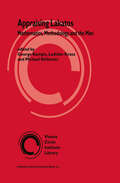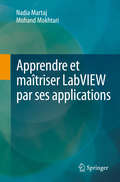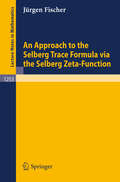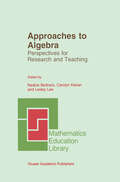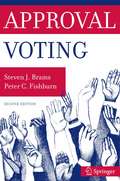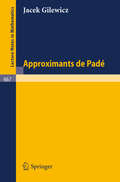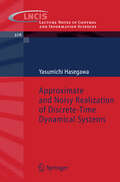- Table View
- List View
Applying the Rasch Model: Fundamental Measurement in the Human Sciences
by Trevor Bond Zi Yan Moritz HeeneRecognised as the most influential publication in the field, ARM facilitates deep understanding of the Rasch model and its practical applications. The authors review the crucial properties of the model and demonstrate its use with examples across the human sciences. Readers will be able to understand and critically evaluate Rasch measurement research, perform their own Rasch analyses and interpret their results. The glossary and illustrations support that understanding, and the accessible approach means that it is ideal for readers without a mathematical background. Highlights of the new edition include: More learning tools to strengthen readers’ understanding including chapter introductions, boldfaced key terms, chapter summaries, activities and suggested readings. Greater emphasis on the use of R packages; readers can download the R code from the Routledge website. Explores the distinction between numerical values, quantity and units, to understand the measurement and the role of the Rasch logit scale (Chapter 4). A new four-option data set from the IASQ (Instrumental Attitude towards Self-assessment Questionnaire) for the Rating Scale Model (RSM) analysis exemplar (Chapter 6). Clarifies the relationship between Rasch measurement, path analysis and SEM, with a host of new examples of Rasch measurement applied across health sciences, education and psychology (Chapter 10). Intended as a text for graduate courses in measurement, item response theory, (advanced) research methods or quantitative analysis taught in psychology, education, human development, business, and other social and health sciences. Professionals in these areas will also appreciate the book’s accessible introduction.
Applying the Rasch Model and Structural Equation Modeling to Higher Education: The Technology Satisfaction Model
by A.Y.M. Atiquil IslamThis book introduces the fundamentals of the technology satisfaction model (TSM), supporting readers in applying the Rasch model and structural equation modeling (SEM) – a multivariate technique – to higher education (HE) research. User satisfaction is traditionally measured along a single dimension. However, the TSM includes digital technologies for teaching, learning and research across three dimensions: computer efficacy, perceived ease of use and perceived usefulness. Establishing relationships among these factors is a challenge. Although commonly used in psychology to trace relationships, Rasch and SEM approaches are rarely used in educational technology or library and information science. This book, therefore, shows that combining these two analytical tools offers researchers better options for measurement and generalisation in HE research. This title presents theoretical and methodological insights of use to researchers in HE.
Applying the Rasch Model and Structural Equation Modeling to Higher Education: The Technology Satisfaction Model
by A.Y.M. Atiquil IslamThis book introduces the fundamentals of the technology satisfaction model (TSM), supporting readers in applying the Rasch model and structural equation modeling (SEM) – a multivariate technique – to higher education (HE) research. User satisfaction is traditionally measured along a single dimension. However, the TSM includes digital technologies for teaching, learning and research across three dimensions: computer efficacy, perceived ease of use and perceived usefulness. Establishing relationships among these factors is a challenge. Although commonly used in psychology to trace relationships, Rasch and SEM approaches are rarely used in educational technology or library and information science. This book, therefore, shows that combining these two analytical tools offers researchers better options for measurement and generalisation in HE research. This title presents theoretical and methodological insights of use to researchers in HE.
Appraising Lakatos: Mathematics, Methodology, and the Man (Vienna Circle Institute Library #1)
by Friedrich StadlerImre Lakatos (1922-1974) was one of the protagonists in shaping the "new philosophy of science". More than 25 years after his untimely death, it is time for a critical re-evaluation of his ideas. His main theme of locating rationality within the scientific process appears even more compelling today, after many historical case studies have revealed the cultural and societal elements within scientific practices. Recently there has been, above all, an increasing interest in Lakatos' philosophy of mathematics, which emphasises heuristics and mathematical practice over logical justification. But suitable modifications of his approach are called for in order to make it applicable to modern axiomatised theories. Pioneering historical research in England and Hungary has unearthed hitherto unknown facts about Lakatos' personal life, his wartime activities and his involvement in the political developments of post-war Europe. From a communist activist committed to Györgyi Lukács' thinking, Lakatos developed into a staunch anti-Marxist who found his intellectual background in Popper's critical rationalism. The volume also publishes for the first time a part of his Debrecen Ph.D. thesis and it is concluded by a bibliography of his Hungarian writings.
Apprendre et maîtriser LabVIEW par ses applications
by Nadia Martaj Mohand MokhtariCet ouvrage traite de l’apprentissage du langage LabVIEW à travers ses applications dans des domaines industriels et académiques, qui permettront à l’ingénieur, technicien ou étudiant d’appréhender rapidement et efficacement ce langage. L’ouvrage commence, dans la partie I, par traiter les différents types de données du langage LabVIEW (tableaux, clusters, complexes, chaînes de caractères…), leur manipulation dans des structures d’exécution (boucles While, For, la structure Condition, etc.), le langage textuel MathScript, des scripts Matlab, la boîte de calcul utilisant la syntaxe du langage C ainsi que les nœuds de propriété qui permettent d’obtenir ou définir la propriété d'un VI. Cette étude est menée à travers des applications d’ingénierie.La partie II est consacrée à l’étude de l’outil « Conception de contrôle et simulation » avec lequel nous pouvons simuler des systèmes analogiques ou discrets.La partie III contient différentes applications qui traitent de nombreux thèmes comme la régulation (différentes structures du PID, les commandes RST, LQI, etc.), la logique floue, le traitement de signal (déterministe, aléatoire et filtrage adaptatif, etc.), le traitement des fichiers de mesure, la statistique expérimentale, etc.
The Apprenticeship of a Mathematician
by Andre WeilFrom reviews: "Extremely readable... rare testimony of a period of the history of 20th century mathematics. Includes very interesting recollections on the author's participation in the formation of the Bourbaki Group, tells of his meetings and conversations with leading mathematicians, reflects his views on mathematics. The book describes an extraordinary career of an exceptional man and mathematicians. Strongly recommended to specialists as well as to the general public." --EMS Newsletter (1992)
An Approach to Multi-agent Systems as a Generalized Multi-synchronization Problem (Understanding Complex Systems)
by Rafael Martínez-Guerra Juan Pablo Flores-FloresThis book addresses the problem of multi-agent systems, considering that it can be interpreted as a generalized multi-synchronization problem. From manufacturing tasks, through encryption and communication algorithms, to high-precision experiments, the simultaneous cooperation between multiple systems or agents is essential to successfully carrying out different modern activities, both in academy and industry. For example, the coordination of multiple assembler robots in manufacturing lines. These agents need to synchronize.The first two chapters of the book describe the synchronization of dynamical systems, paying special attention to the synchronization of non-identical systems. Following, the third chapter presents an interesting application of the synchronization phenomenon for state estimation. Subsequently, the authors fully address the multi-agent problem interpreted as multi-synchronization. The final chapters introduce the reader to a more complex problem, the synchronization of systems governed by partial differential equations, both of integer and fractional order.The book aimed at graduates, postgraduate students and researchers closely related to the area of automatic control. Previous knowledge of linear algebra, classical and fractional calculus is requested, as well as some fundamental notions of graph theory.
An Approach to the Selberg Trace Formula via the Selberg Zeta-Function (Lecture Notes in Mathematics #1253)
by Jürgen FischerThe Notes give a direct approach to the Selberg zeta-function for cofinite discrete subgroups of SL (2,#3) acting on the upper half-plane. The basic idea is to compute the trace of the iterated resolvent kernel of the hyperbolic Laplacian in order to arrive at the logarithmic derivative of the Selberg zeta-function. Previous knowledge of the Selberg trace formula is not assumed. The theory is developed for arbitrary real weights and for arbitrary multiplier systems permitting an approach to known results on classical automorphic forms without the Riemann-Roch theorem. The author's discussion of the Selberg trace formula stresses the analogy with the Riemann zeta-function. For example, the canonical factorization theorem involves an analogue of the Euler constant. Finally the general Selberg trace formula is deduced easily from the properties of the Selberg zeta-function: this is similar to the procedure in analytic number theory where the explicit formulae are deduced from the properties of the Riemann zeta-function. Apart from the basic spectral theory of the Laplacian for cofinite groups the book is self-contained and will be useful as a quick approach to the Selberg zeta-function and the Selberg trace formula.
Approaches and Applications of Inductive Programming: Third International Workshop, AAIP 2009, Edinburgh, UK, September 4, 2009, Revised Papers (Lecture Notes in Computer Science #5812)
by Ute Schmid Emanuel KitzelmannApproaches, Opportunities, and Challenges for Eco-design 4.0: A Concise Guide for Practitioners and Students
by Samira KeivanpourThis book addresses the implications of the Industry 4.0 paradigm in design for the environment. We examine the opportunities for, and challenges of, the implications of cyber-physical systems, big data analytics, Internet of things, additive manufacturing, and simulation in a range of areas in an eco-design context. These include selecting low impact materials, choosing manufacturing processes with environmental considerations, end of life strategies, applying design approaches for disassembly, integrating economic and social components into environmental studies, and stakeholder’s involvement. This volume takes a step toward this journey to explore how the three pillars of technology, sustainability, and evolving consumers could shape the future of the product’s design.
Approaches to Algebra: Perspectives for Research and Teaching (Mathematics Education Library #18)
by N. Bednarz C. Kieran L. LeeIn Greek geometry, there is an arithmetic of magnitudes in which, in terms of numbers, only integers are involved. This theory of measure is limited to exact measure. Operations on magnitudes cannot be actually numerically calculated, except if those magnitudes are exactly measured by a certain unit. The theory of proportions does not have access to such operations. It cannot be seen as an "arithmetic" of ratios. Even if Euclidean geometry is done in a highly theoretical context, its axioms are essentially semantic. This is contrary to Mahoney's second characteristic. This cannot be said of the theory of proportions, which is less semantic. Only synthetic proofs are considered rigorous in Greek geometry. Arithmetic reasoning is also synthetic, going from the known to the unknown. Finally, analysis is an approach to geometrical problems that has some algebraic characteristics and involves a method for solving problems that is different from the arithmetical approach. 3. GEOMETRIC PROOFS OF ALGEBRAIC RULES Until the second half of the 19th century, Euclid's Elements was considered a model of a mathematical theory. This may be one reason why geometry was used by algebraists as a tool to demonstrate the accuracy of rules otherwise given as numerical algorithms. It may also be that geometry was one way to represent general reasoning without involving specific magnitudes. To go a bit deeper into this, here are three geometric proofs of algebraic rules, the frrst by Al-Khwarizmi, the other two by Cardano.
Approaches to Geo-mathematical Modelling: New Tools for Complexity Science (Wiley Series in Computational and Quantitative Social Science)
by Alan G. WilsonGeo-mathematical modelling: models from complexity science Sir Alan Wilson, Centre for Advanced Spatial Analysis, University College London Mathematical and computer models for a complexity science tool kit Geographical systems are characterised by locations, activities at locations, interactions between them and the infrastructures that carry these activities and flows. They can be described at a great variety of scales, from individuals and organisations to countries. Our understanding, often partial, of these entities, and in many cases this understanding is represented in theories and associated mathematical models. In this book, the main examples are models that represent elements of the global system covering such topics as trade, migration, security and development aid together with examples at finer scales. This provides an effective toolkit that can not only be applied to global systems, but more widely in the modelling of complex systems. All complex systems involve nonlinearities involving path dependence and the possibility of phase changes and this makes the mathematical aspects particularly interesting. It is through these mechanisms that new structures can be seen to ‘emerge’, and hence the current notion of ‘emergent behaviour’. The range of models demonstrated include account-based models and biproportional fitting, structural dynamics, space-time statistical analysis, real-time response models, Lotka-Volterra models representing ‘war’, agent-based models, epidemiology and reaction-diffusion approaches, game theory, network models and finally, integrated models. Geo-mathematical modelling: Presents mathematical models with spatial dimensions. Provides representations of path dependence and phase changes. Illustrates complexity science using models of trade, migration, security and development aid. Demonstrates how generic models from the complexity science tool kit can each be applied in a variety of situations This book is for practitioners and researchers in applied mathematics, geography, economics, and interdisciplinary fields such as regional science and complexity science. It can also be used as the basis of a modelling course for postgraduate students.
Approaches to Geo-mathematical Modelling: New Tools for Complexity Science (Wiley Series in Computational and Quantitative Social Science)
by Alan G. WilsonGeo-mathematical modelling: models from complexity science Sir Alan Wilson, Centre for Advanced Spatial Analysis, University College London Mathematical and computer models for a complexity science tool kit Geographical systems are characterised by locations, activities at locations, interactions between them and the infrastructures that carry these activities and flows. They can be described at a great variety of scales, from individuals and organisations to countries. Our understanding, often partial, of these entities, and in many cases this understanding is represented in theories and associated mathematical models. In this book, the main examples are models that represent elements of the global system covering such topics as trade, migration, security and development aid together with examples at finer scales. This provides an effective toolkit that can not only be applied to global systems, but more widely in the modelling of complex systems. All complex systems involve nonlinearities involving path dependence and the possibility of phase changes and this makes the mathematical aspects particularly interesting. It is through these mechanisms that new structures can be seen to ‘emerge’, and hence the current notion of ‘emergent behaviour’. The range of models demonstrated include account-based models and biproportional fitting, structural dynamics, space-time statistical analysis, real-time response models, Lotka-Volterra models representing ‘war’, agent-based models, epidemiology and reaction-diffusion approaches, game theory, network models and finally, integrated models. Geo-mathematical modelling: Presents mathematical models with spatial dimensions. Provides representations of path dependence and phase changes. Illustrates complexity science using models of trade, migration, security and development aid. Demonstrates how generic models from the complexity science tool kit can each be applied in a variety of situations This book is for practitioners and researchers in applied mathematics, geography, economics, and interdisciplinary fields such as regional science and complexity science. It can also be used as the basis of a modelling course for postgraduate students.
Approaches to Qualitative Research in Mathematics Education: Examples of Methodology and Methods (Advances in Mathematics Education)
by Angelika Bikner-Ahsbahs Christine Knipping Norma PresmegThis volume documents a range of qualitative research approaches emerged within mathematics education over the last three decades, whilst at the same time revealing their underlying methodologies. Continuing the discussion as begun in the two 2003 ZDM issues dedicated to qualitative empirical methods, this book presents astate of the art overview on qualitative research in mathematics education and beyond. The structure of the book allows the reader to use it as an actual guide for the selection of an appropriate methodology, on a basis of both theoretical depth and practical implications. The methods and examples illustrate how different methodologies come to life when applied to a specific question in a specific context. Many of the methodologies described are also applicable outside mathematics education, but the examples provided are chosen so as to situate the approach in a mathematical context.
Approaches to Singular Analysis: A Volume of Advances in Partial Differential Equations (Operator Theory: Advances and Applications #125)
by Juan B. Gil Daniel Grieser Matthias LeschThis collection presents various approaches to analytic problems that arise in the context of singular spaces. It contains articles offering introductions to various pseudodifferential calculi and discussions of relations between them, plus invited papers from mathematicians who have made significant contributions to this field
Approaching Infinity
by M. HuemerApproaching Infinity addresses seventeen paradoxes of the infinite, most of which have no generally accepted solutions. The book addresses these paradoxes using a new theory of infinity, which entails that an infinite series is uncompletable when it requires something to possess an infinite intensive magnitude. Along the way, the author addresses the nature of numbers, sets, geometric points, and related matters.The book addresses the need for a theory of infinity, and reviews both old and new theories of infinity. It discussing the purposes of studying infinity and the troubles with traditional approaches to the problem, and concludes by offering a solution to some existing paradoxes.
Approaching Multivariate Analysis, 2nd Edition: A Practical Introduction
by Pat Dugard John Todman Harry StainesThis fully updated new edition not only provides an introduction to a range of advanced statistical techniques that are used in psychology, but has been expanded to include new chapters describing methods and examples of particular interest to medical researchers. It takes a very practical approach, aimed at enabling readers to begin using the methods to tackle their own problems. This book provides a non-mathematical introduction to multivariate methods, with an emphasis on helping the reader gain an intuitive understanding of what each method is for, what it does and how it does it. The first chapter briefly reviews the main concepts of univariate and bivariate methods and provides an overview of the multivariate methods that will be discussed, bringing out the relationships among them, and summarising how to recognise what types of problem each of them may be appropriate for tackling. In the remaining chapters, introductions to the methods and important conceptual points are followed by the presentation of typical applications from psychology and medicine, using examples with fabricated data. Instructions on how to do the analyses and how to make sense of the results are fully illustrated with dialogue boxes and output tables from SPSS, as well as details of how to interpret and report the output, and extracts of SPSS syntax and code from relevant SAS procedures. This book gets students started, and prepares them to approach more comprehensive treatments with confidence. This makes it an ideal text for psychology students, medical students and students or academics in any discipline that uses multivariate methods.
Approaching Multivariate Analysis, 2nd Edition: A Practical Introduction
by Pat Dugard John Todman Harry StainesThis fully updated new edition not only provides an introduction to a range of advanced statistical techniques that are used in psychology, but has been expanded to include new chapters describing methods and examples of particular interest to medical researchers. It takes a very practical approach, aimed at enabling readers to begin using the methods to tackle their own problems. This book provides a non-mathematical introduction to multivariate methods, with an emphasis on helping the reader gain an intuitive understanding of what each method is for, what it does and how it does it. The first chapter briefly reviews the main concepts of univariate and bivariate methods and provides an overview of the multivariate methods that will be discussed, bringing out the relationships among them, and summarising how to recognise what types of problem each of them may be appropriate for tackling. In the remaining chapters, introductions to the methods and important conceptual points are followed by the presentation of typical applications from psychology and medicine, using examples with fabricated data. Instructions on how to do the analyses and how to make sense of the results are fully illustrated with dialogue boxes and output tables from SPSS, as well as details of how to interpret and report the output, and extracts of SPSS syntax and code from relevant SAS procedures. This book gets students started, and prepares them to approach more comprehensive treatments with confidence. This makes it an ideal text for psychology students, medical students and students or academics in any discipline that uses multivariate methods.
Approaching the Kannan-Lovász-Simonovits and Variance Conjectures (Lecture Notes in Mathematics #2131)
by David Alonso-Gutiérrez Jesús BasteroFocusing on two central conjectures of Asymptotic Geometric Analysis, the Kannan-Lovász-Simonovits spectral gap conjecture and the variance conjecture, these Lecture Notes present the theory in an accessible way, so that interested readers, even those who are not experts in the field, will be able to appreciate the treated topics. Offering a presentation suitable for professionals with little background in analysis, geometry or probability, the work goes directly to the connection between isoperimetric-type inequalities and functional inequalities, giving the interested reader rapid access to the core of these conjectures.In addition, four recent and important results in this theory are presented in a compelling way. The first two are theorems due to Eldan-Klartag and Ball-Nguyen, relating the variance and the KLS conjectures, respectively, to the hyperplane conjecture. Next, the main ideas needed prove the best known estimate for the thin-shell width given by Guédon-Milman and an approach to Eldan's work on the connection between the thin-shell width and the KLS conjecture are detailed.
Approval Voting
by Steven Brams Peter C. FishburnThis book presents a simple and logical potential electoral reform. Under this system, voters may vote for, or approve of, as many candidates as they like in multicandidate elections. Among the many benefits of approval voting are its propensity to elect the majority candidate, its relative invulnerability to insincere or strategic voting, and a probable increase in voter turnout.
Approximability of Optimization Problems through Adiabatic Quantum Computation (Synthesis Lectures on Quantum Computing)
by William Cruz-Santos Guillermo Morales-LunaThe adiabatic quantum computation (AQC) is based on the adiabatic theorem to approximate solutions of the Schrödinger equation. The design of an AQC algorithm involves the construction of a Hamiltonian that describes the behavior of the quantum system. This Hamiltonian is expressed as a linear interpolation of an initial Hamiltonian whose ground state is easy to compute, and a final Hamiltonian whose ground state corresponds to the solution of a given combinatorial optimization problem. The adiabatic theorem asserts that if the time evolution of a quantum system described by a Hamiltonian is large enough, then the system remains close to its ground state. An AQC algorithm uses the adiabatic theorem to approximate the ground state of the final Hamiltonian that corresponds to the solution of the given optimization problem. In this book, we investigate the computational simulation of AQC algorithms applied to the MAX-SAT problem. A symbolic analysis of the AQC solution is given in order to understand the involved computational complexity of AQC algorithms. This approach can be extended to other combinatorial optimization problems and can be used for the classical simulation of an AQC algorithm where a Hamiltonian problem is constructed. This construction requires the computation of a sparse matrix of dimension 2n × 2n, by means of tensor products, where n is the dimension of the quantum system. Also, a general scheme to design AQC algorithms is proposed, based on a natural correspondence between optimization Boolean variables and quantum bits. Combinatorial graph problems are in correspondence with pseudo-Boolean maps that are reduced in polynomial time to quadratic maps. Finally, the relation among NP-hard problems is investigated, as well as its logical representability, and is applied to the design of AQC algorithms. It is shown that every monadic second-order logic (MSOL) expression has associated pseudo-Boolean maps that can be obtained by expanding the given expression, and also can be reduced to quadratic forms. Table of Contents: Preface / Acknowledgments / Introduction / Approximability of NP-hard Problems / Adiabatic Quantum Computing / Efficient Hamiltonian Construction / AQC for Pseudo-Boolean Optimization / A General Strategy to Solve NP-Hard Problems / Conclusions / Bibliography / Authors' Biographies
Approximate Analytical Methods for Solving Ordinary Differential Equations
by T.S.L Radhika T. Iyengar T. RaniApproximate Analytical Methods for Solving Ordinary Differential Equations (ODEs) is the first book to present all of the available approximate methods for solving ODEs, eliminating the need to wade through multiple books and articles. It covers both well-established techniques and recently developed procedures, including the classical series solut
Approximate and Noisy Realization of Discrete-Time Dynamical Systems (Lecture Notes in Control and Information Sciences #Vol. 376)
by Yasumichi HasegawaThis monograph deals with approximation and noise cancellation of dynamical systems which include linear and nonlinear input/output relations. It will be of special interest to researchers, engineers and graduate students who have specialized in ?ltering theory and system theory. From noisy or noiseless data, reductionwillbemade.Anewmethodwhichreducesnoiseormodelsinformation will be proposed. Using this method will allow model description to be treated as noise reduction or model reduction. As proof of the e?cacy, this monograph provides new results and their extensions which can also be applied to nonlinear dynamical systems. To present the e?ectiveness of our method, many actual examples of noise and model information reduction will also be provided. Using the analysis of state space approach, the model reduction problem may have become a major theme of technology after 1966 for emphasizing e?ciency in the ?elds of control, economy, numerical analysis, and others. Noise reduction problems in the analysis of noisy dynamical systems may havebecomeamajorthemeoftechnologyafter1974foremphasizinge?ciencyin control.However,thesubjectsoftheseresearcheshavebeenmainlyconcentrated in linear systems. In common model reduction of linear systems in use today, a singular value decompositionofaHankelmatrixisusedto?ndareducedordermodel.However, the existence of the conditions of the reduced order model are derived without evaluationoftheresultantmodel.Inthecommontypicalnoisereductionoflinear systems in use today, the order and parameters of the systems are determined by minimizing information criterion. Approximate and noisy realization problems for input/output relations can be roughly stated as follows: A. The approximate realization problem. For any input/output map, ?nd one mathematical model such that it is similar totheinput/outputmapandhasalowerdimensionthanthegivenminimalstate spaceofadynamicalsystemwhichhasthesamebehaviortotheinput/outputmap. B. The noisy realization problem.
Approximate and Renormgroup Symmetries (Nonlinear Physical Science)
by N. Kh. Ibragimov Vladimir F. Kovalev"Approximate and Renormgroup Symmetries" deals with approximate transformation groups, symmetries of integro-differential equations and renormgroup symmetries. It includes a concise and self-contained introduction to basic concepts and methods of Lie group analysis, and provides an easy-to-follow introduction to the theory of approximate transformation groups and symmetries of integro-differential equations. The book is designed for specialists in nonlinear physics - mathematicians and non-mathematicians - interested in methods of applied group analysis for investigating nonlinear problems in physical science and engineering. Dr. N.H. Ibragimov is a professor at the Department of Mathematics and Science, Research Centre ALGA, Sweden. He is widely regarded as one of the world's foremost experts in the field of symmetry analysis of differential equations; Dr. V. F. Kovalev is a leading scientist at the Institute for Mathematical Modeling, Russian Academy of Science, Moscow.


